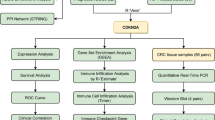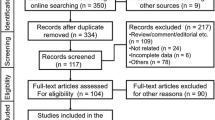Abstract
The ectonucleotidase CD39 is pivotal in the conversion of immunostimulatory adenosine triphosphate (ATP) into immunosuppressive adenosine which potently inhibits host immune responses against cancer. This study investigated the expression level and prognostic significance of CD39 in human rectal adenocarcinoma. Our data demonstrated that CD39 staining strongly marked malignant epithelial cells where the protein and messenger RNA (mRNA) expression levels of CD39 were significantly increased compared with paracancerous controls. In addition to primary tumors, CD39 was also abundantly expressed in liver metastases and tumor-draining lymph nodes from metastatic rectal adenocarcinoma. Although patients with higher CD39 density in tumor cells were more likely to have favorable characteristics (early TNM and N stages) and overall survival, the singular parameter cannot be used as an independent factor for predicting patients’ prognosis. Intriguingly, combined analysis of CD39 and CD73 expression was more efficient to foretell patient’s outcome where patients with increased CD73 but decreased CD39 levels displayed a worst prognosis. Taken together, the current study revealed that malignant epithelial cells of human rectal adenocarcinoma strongly express CD39 that may play a potential role in the tumor invasion and metastasis. Although high expression of CD39 in tumor cells is correlated with favorable clinical outcome, the combination of CD39 and CD73 expression may have a better prognostic value.






Similar content being viewed by others
References
Torre LA, Bray F, Siegel RL, Ferlay J, Lortet-Tieulent J, Jemal A. Global cancer statistics, 2012. CA Cancer J Clin. 2015;65:87–108.
Brenner H, Kloor M, Pox CP. Colorectal cancer. Lancet. 2014;383:1490–502.
Bastid J, Regairaz A, Bonnefoy N, Dejou C, Guistiniani J, Laheurte C, et al. Inhibition of CD39 enzymatic function at the surface of tumor cells alleviates their immunosuppressive activity. Cancer Immunol Res. 2015;3:254–65.
Clayton A, Al-Taei S, Webber J, Mason MD, Tabi Z. Cancer exosomes express CD39 and CD73, which suppress T cells through adenosine production. J Immunol. 2011;187:676–83.
Feng L, Sun X, Csizmadia E, Han L, Bian S, Murakami T, et al. Vascular CD39/ENTPD1 directly promotes tumor cell growth by scavenging extracellular adenosine triphosphate. Neoplasia. 2011;13:206–16.
Deaglio S, Dwyer KM, Gao W, Friedman D, Usheva A, Erat A, et al. Adenosine generation catalyzed by CD39 and CD73 expressed on regulatory T cells mediates immune suppression. J Exp Med. 2007;204:1257–65.
Chalmin F, Mignot G, Bruchard M, Chevriaux A, Végran F, Hichami A, et al. Stat3 and Gfi-1 transcription factors control Th17 cell immunosuppressive activity via the regulation of ectonucleotidase expression. Immunity. 2012;36:362–73.
Zhang B, Wang Z, Wu L, Zhang M, Li W, Ding J, et al. Circulating and tumor-infiltrating myeloid-derived suppressor cells in patients with colorectal carcinoma. PLoS ONE. 2013;8:e57114.
Stagg J, Smyth MJ. Extracellular adenosine triphosphate and adenosine in cancer. Oncogene. 2010;29:5346–58.
Antonioli L, Blandizzi C, Pacher P, Haskó G. Immunity, inflammation and cancer: a leading role for adenosine. Nat Rev Cancer. 2013;13:842–57.
Burnstock G, Di Virgilio F. Purinergic signalling and cancer. Purinergic Signal. 2013;9:491–540.
Antonioli L, Pacher P, Vizi ES, Haskó G. CD39 and CD73 in immunity and inflammation. Trends Mol Med. 2013;19:355–67.
Bastid J, Cottalorda-Regairaz A, Alberici G, Bonnefoy N, Eliaou JF, Bensussan A. ENTPD1/CD39 is a promising therapeutic target in oncology. Oncogene. 2013;32:1743–51.
Sun X, Wu Y, Gao W, Enjyoji K, Csizmadia E, Muller CE, et al. CD39/ENTPD1 expression by CD4+ Foxp3+ regulatory T cells promotes hepatic metastatic tumor growth in mice. Gastroenterology. 2010;139:1030–40.
Kunzli BM, Bernlochner MI, Rath S, Kaser S, Csizmadia E, Enjyoji K, et al. Impact of CD39 and purinergic signalling on the growth and metastasis of colorectal cancer. Purinergic Signal. 2011;7:231–41.
Young A, Mittal D, Stagg J, Smyth MJ. Targeting cancer-derived adenosine: new therapeutic approaches. Cancer Discov. 2014;4:879–88.
Häusler SF, Del Barrio IM, Diessner J, Stein RG, Strohschein J, Hönig A, et al. Anti-CD39 and anti-CD73 antibodies A1 and 7G2 improve targeted therapy in ovarian cancer by blocking adenosine-dependent immune evasion. Am J Transl Res. 2014;6:129–39.
Yamauchi M, Lochhead P, Morikawa T, Huttenhower C, Chan AT, Giovannucci E, et al. Colorectal cancer: a tale of two sides or a continuum? Gut. 2012;61:794–7.
Zhang B, Song B, Wang X, Chang XS, Pang T, Zhang X, et al. The expression and clinical significance of CD73 molecule in human rectal adenocarcinoma. Tumor Biol. 2015;13. doi:10.1007/s13277-015-3212-x.
Künzli BM, Berberat PO, Giese T, Csizmadia E, Kaczmarek E, Baker C, et al. Upregulation of CD39/NTPDases and P2 receptors in human pancreatic disease. Am J Physiol Gastrointest Liver Physiol. 2007;292:G223–30.
Häusler SF, Montalbán del Barrio I, Strohschein J, Anoop Chandran P, Engel JB, Hönig A, et al. Ectonucleotidases CD39 and CD73 on OvCA cells are potent adenosine-generating enzymes responsible for adenosine receptor 2A-dependent suppression of T cell function and NK cell cytotoxicity. Cancer Immunol Immunother. 2011;60:1405–18.
Wu XR, He XS, Chen YF, Yuan RX, Zeng Y, Lian L, et al. High expression of CD73 as a poor prognostic biomarker in human colorectal cancer. J Surg Oncol. 2012;106:130–7.
Pagnotta SM, Laudanna C, Pancione M, Sabatino L, Votino C, Remo A, et al. Ensemble of gene signatures identifies novel biomarkers in colorectal cancer activated through PPARγ and TNFα signaling. PLoS One. 2013;8:e72638.
Acknowledgments
A special thanks to Pro. Wen Wen for his technical assistance.
Funding
This work was supported by the Beijing Natural Science Foundation (7133254 to Bin Zhang). The funders had no role in the study design, data collection and analysis, decision to publish, or preparation of the manuscript.
Conflicts of interest
None
Author information
Authors and Affiliations
Corresponding authors
Electronic supplementary material
Below is the link to the electronic supplementary material.
Supporting Figure 1
IHC characteristics of CD39 and CD73 in human rectal adenocarcinoma. (a, b) Representative IHC images of tumoral CD39 and CD73 in the same tumor area. The digital images analyzed with the Aperio ImageScope software (×200-fold magnification). Micrograph indicates the amplified morphology of tissue. Black scale bars, 100 um. (JPEG 2716 kb)
Supporting Figure 2
The prognostic significance of combining tumoral CD39 and CD73 expression in human rectal adenocarcinoma. (a, b, c) The OS rates of patients with high (above median) or low (below median) CD39 and CD73 levels in tumor cells were compared using Kaplan-Meier analysis. (GIF 62 kb)
Supporting Table 1
(DOC 44 kb)
Supporting Table 2
(DOC 45 kb)
Supporting Table 3
(DOC 43 kb)
Rights and permissions
About this article
Cite this article
Zhang, B., Cheng, B., Li, FS. et al. High expression of CD39/ENTPD1 in malignant epithelial cells of human rectal adenocarcinoma. Tumor Biol. 36, 9411–9419 (2015). https://doi.org/10.1007/s13277-015-3683-9
Received:
Accepted:
Published:
Issue Date:
DOI: https://doi.org/10.1007/s13277-015-3683-9




